Martienssen W., Warlimont H. (Eds.). Handbook of Condensed Matter and Materials Data
Подождите немного. Документ загружается.

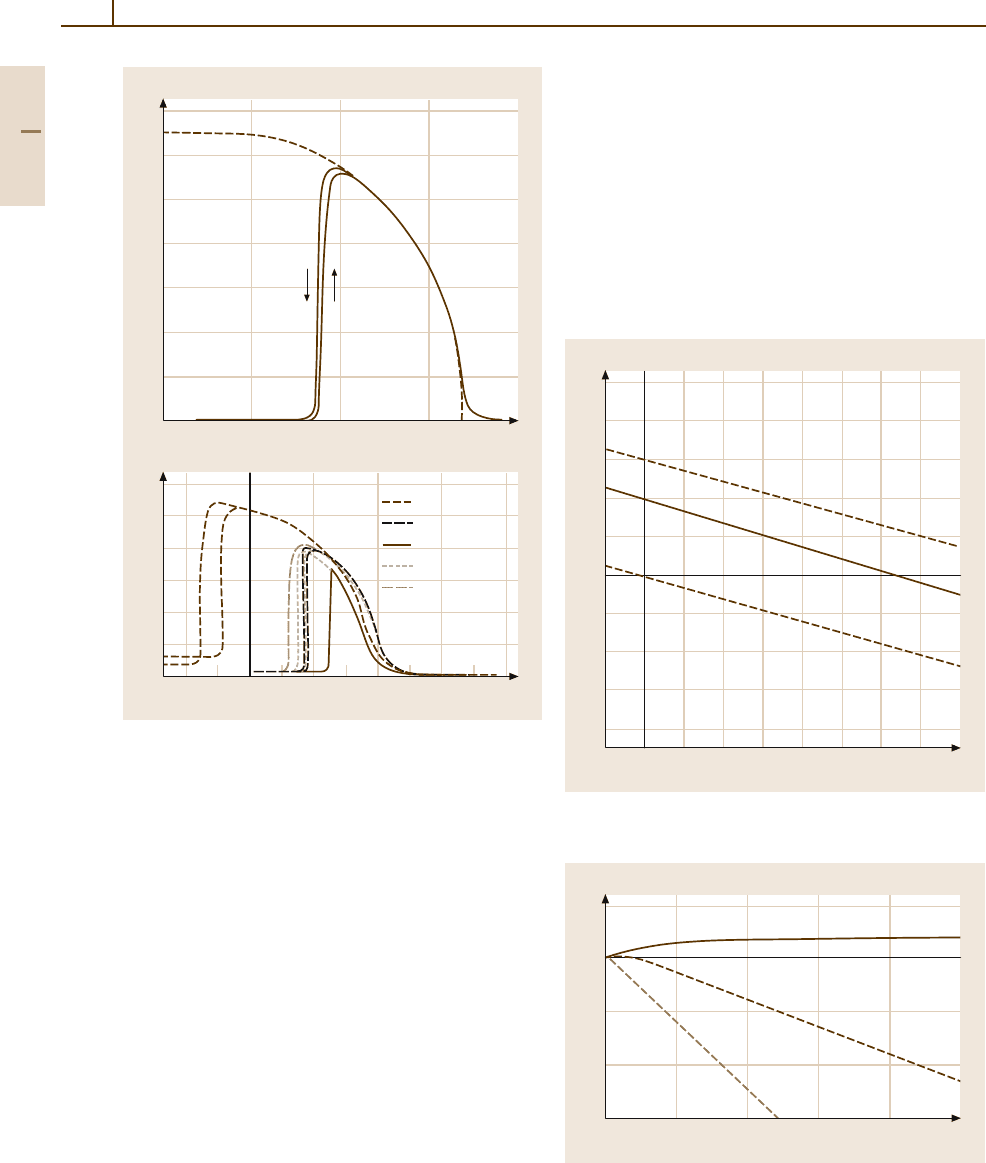
392 Part 3 Classes of Materials
140
120
100
80
60
40
20
0
200 800
Temperature (K)
120
100
80
60
40
20
0
–200 800
Temperature (°C)
400 600
0 200 400 600
a) Magnetization (emu g
–1
)
b) Magnetization (emu g
–1
)
FeRh Pd
0.0833
FeRh Ru
0.0833
FeRh Ir
0.0833
FeRh Pt
0.0833
FeRh Os
0.0833
σ
Calculated for S = 1
Fig. 3.1-312a,b Metamagnetic behavior of (a) FeRh su-
perlattice alloy [1.218, p. 102].
(b) Variation by addition
of small amounts of Pd, Ru, Ir, Pt, Os [1.218, p. 102]
Thermal Properties.
Tables 3.1-212–3.1-214 show
the recrystalization temperature, thermal conductivity
and thermal expansion at different temperatures. Va-
por pressure at different temperatures is shown in
Fig. 3.1-273.
Optical Properties. Rhodium has the highest optical re-
flectivity of all platinum-group metals (Fig. 3.1-274),
ranging about 20% below the reflectivity of Ag.
It is used as hard and corrosion-resistant coat-
ing on silver jewelry and for optical reflectors.
Data of the spectral emissivity are given in
Table 3.1-216.
Diffusion. Data for self-diffusion are given in
Table 3.1-217 (see [1.216] for further data).
Chemical Properties. Rhodium is not attacked by acids
or alkali even under oxidizing conditions (aqua regia)
(Fig. 3.1-313). Sodium hypochlorite attacks in the order
of increasing strength: Pt = Rh = Ir =Ru < Pd < Os.
Heating in air causes the formation of thin oxide lay-
ers above 600
◦
C which decompose above 1100
◦
C
(Fig. 3.1-314). Pt alloys with 5–40 wt% Rh are
corrosion-resistant against H
2
F
2
. A detailed survey
about these chemical properties is given in [1.216].
Rhodium is the effective component of the three-
way Pt/Pd/Rh alloy autocatalyst for the reduction of
2.0
1.6
1.2
0.8
0.4
0
–0.4
–0.8
–1.2
–1.6
–2 16
pH
02468101214
Immune
Passive
a
b
Potential (V)
Fig. 3.1-313 Potential pH diagram for the system
Rh
−
H
2
O [1.217, p. 202]
+20
0
–20
–40
–60
020
Time (h)
4 8 12 16
1300°C
1200°C
1100°C
Weight change (10
–2
mg cm
–2
)
Fig. 3.1-314 Weight change of Rh in oxygen [1.217, p. 185]
Part 3 1.10

Metals 1.10 Noble Metals and Noble Metal Alloys 393
15
10
5
400
Temperature (K)
3
2
1
600
Temperature (K)
500 600
800 1000 1200
a) NH
3
formation rate (10
11
molecule cm
–2
s
–1
)
b) N
2
formation rate (10
13
molecule cm
–2
s
–1
)
Pd
Rh
Rh
Pd
Fig. 3.1-315a,b Product formation rates in N =−H
2
reactions on Pd- and Rh-catalyst foils. (a) NH
3
forma-
tion rates p(NO) = 9.4×10
−5
Pa, p(H
2
) = 4.9×10
−5
Pa.
(b) N
2
formation rates p(NO) = 1.1×10
−5
Pa, p(H
2
) =
1.9×10
−5
Pa [1.218, p. 287]
NO
x
of exhaustion gases (Figs. 3.1-315a,b). Rhatalysts
surpass the group homolog, Co-based catalysts, with
lower reaction pressures and temperatures and higher
yields [1.216]. Complex organic rhodium compounds
on the basis of RhCl (PPH
3
) with different substi-
tute ligands are important homogeneous catalysts in
the technical production processes for hydrogenation
and hydroformulation (“oxo”-processes, e.g., synthesis
a)
MeO
AcO
COOH
NHAc
MeO
AcO
COOH
H
NHAc
HO COOH
H
NHAc
[Rh ((R, R)-(DiPAMP) COD] BF
4
10 bar H
2,
25 °C
ton 20 000, tof 1000 h
–1
100 % yield; 95% ee
L-DOPA
HO
NEt
2
NEt
2
OH
100 °C
[Rh-(–)-BINAP(COD)]CIO
4
ton 400 000
tof 440 h
–1
3 steps
94% ee
… allylamine
… enamine
L-menthol
b)
Fig. 3.1-316a,b Examples of organic synthesis of chiral compounds catalysed by complex Rh compounds. (a) L-DOPA.
(b) L-menthol [1.291, p. 83]
of aldehydes and acetic acid). Replacement of PPH
3
by complex chiral phosphan ligands enables the syn-
thesis of asymmetric compounds, e.g., L-DOPA and
L-menthol (Fig. 3.1-316a,b) [1.291].
Iridium and Iridium Alloys
Applications. Iridium is used for crucibles to grow high-
purity crystals for lasers, medical scanners etc., anodes
to prevent corrosion of shipping vessels and under-water
structures, coatings of electrodes for the manufacturing
of chlorine and caustic soda, as an alloy component
of automotive exhaust catalysts, and as alloy compo-
nent and compounds of chemical process catalysts for
the production of acetic acid and complex organic com-
pounds. Iridium is an effective hardener for materials
used at high temperature, high wear, and high corrosion
conditions (e.g., spark plugs). It is also used as fine-
grain forming addition in jewelry and dental gold alloys.
Commercial grades available are powder, shot, ingot,
and wire in a purity ranging from 98–99.9% (ASTM
671-81, reappraised 1987).
Production. Iridium is produced as powder and sponge
by chemical reduction or thermal decomposition of the
chloro–ammonia compound (NH
4
)
2
[IrCl
6
]. Bars, rods,
ingot, and wires are produced by compacting of powder
followed by extrusion. Coatings are produced galvani-
cally, by evaporation, or by sputtering.
Phases and Phase Equilibria. Figures 3.1-317–
3.1-319 [1.216] show the binary phase diagrams of
Ir alloys with Pt, Rh, and Ru. Miscibility gaps
exist in the solid state also in the alloy sys-
tems with Cu, Os, Re, and Ru. Iridium alloyed in
Fe lowers the α–λ transition temperature consider-
Part 3 1.10
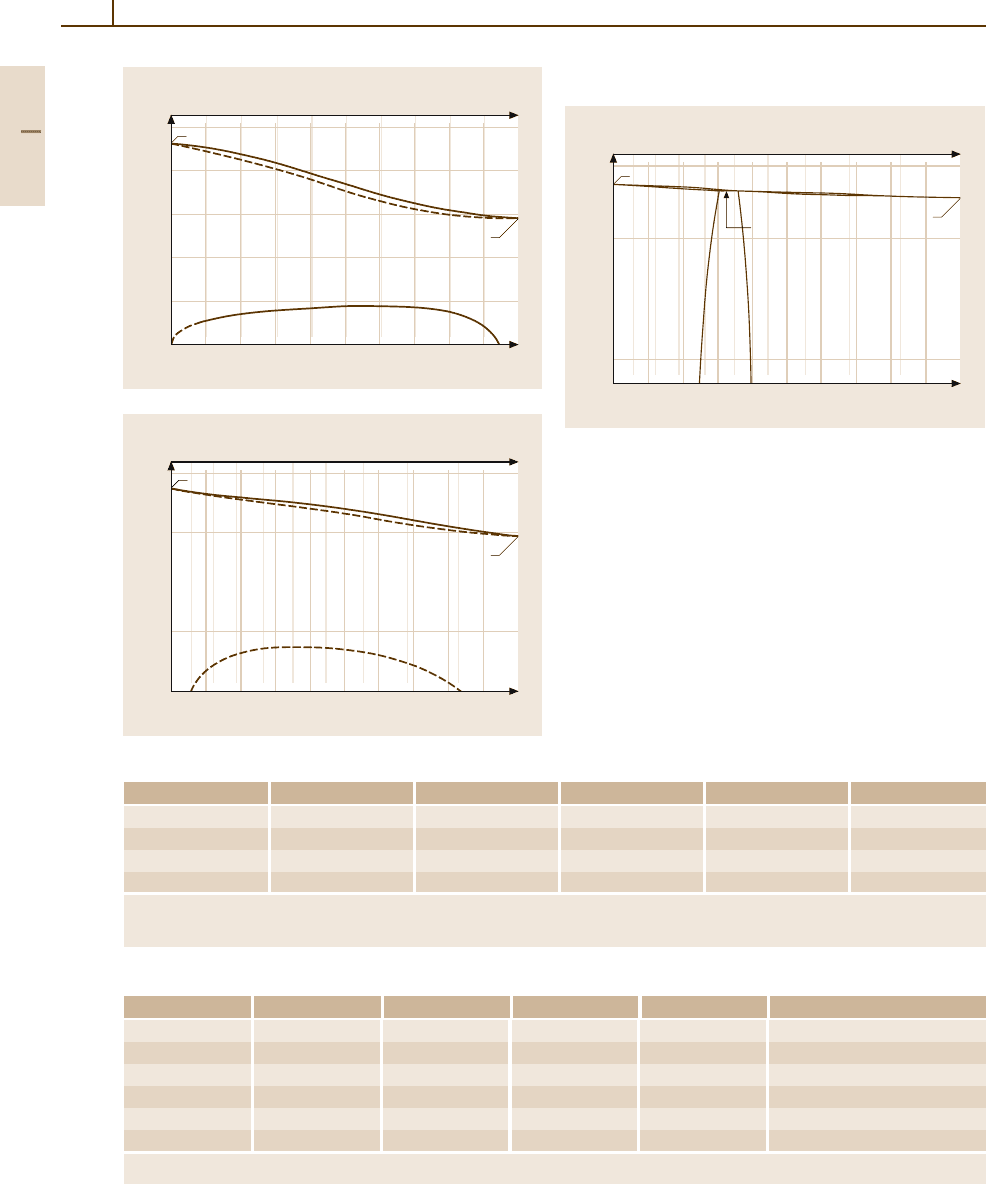
394 Part 3 Classes of Materials
2600
2200
1800
1400
1000
600
0
100
Platinum (wt %) Pt
0 102030405060708090
Ir
10 20 30 40 50 60 70 80 90 100
Temperature (°C) Platinum (at. %)
L
(Ir) + (Pt)
(Ir, Pt)
1769 °C
2447 °C
2600
2000
1000
400
0
100
Rhodium (wt %) Rh
0102030405060708090
Ir
10 20 30 40 50 60 70 80 90 100
Temperature (°C) Rhodium (at. %)
1963 °C
2447 °C
(Ir) + (Rh)
(Ir, Rh)
L
~ 850 °C
Table 3.1-248 Thermodynamic data of Ir [1.217, p. 109]
T (K) c
p
(J/K mol) S (J/K mol) H (J/mol) G (J/mol) p (atm)
298.15 24.979 35.505 0 −10.586
400 25.695 42.946 2.581 −14.598 6.70× 10
−80
800 28.51 61.62 13.442 −35.875 2.81 × 10
−36
1400 32.733 78.647 31.795 −78.311 1.15 × 10
−17
T = Temperature, c
p
= specific heat capacity, S = Entropy, H = Enthalpy, G = free Enthalpy,
p = partial pressure of the pure elements
Table 3.1-249 Structure and lattice parameter of intermediate compounds [1.217, p. 117f f,]
Phase Pearson symbol a (nm) b (nm) c (nm) Concentration x A(1 −x)B(x)
Cu
−
Ir cF4 0.3629
Ir
−
Os hP2 0.27361 0.43417 0.65
Ir
−
Os cF4 0.38358 0.2
Ir
−
Rh cF4 0.3824 0.5
Ir
−
Ru hP2 0.2718 0.4331 0.56
Ir
−
Ru cF4 0.3818 0.47
HT = high temperature modification, LT = low temperature modification
Fig. 3.1-317 Phase diagram of Ir
−
Pt [1.217, p. 88]
2600
2000
1000
800
0
100
Ruthenium (wt %) Ru
0102030405060708090
Ir
10 20 30 40 50 60 70 80 90 100
Temperature (°C) Ruthenium (at. %)
2334 °C
L
(Ru)(Ir)
2447 °C
2395°C
35.4
36.3
30
Fig. 3.1-319 Phase diagram of Ir
−
Ru [1.217, p. 89]
ably (Fig. 3.1-343). Thermodynamic data are given in
Table 3.1-248 [1.216].
Structure and lattice parameters of selected in-
termediate compounds are given in Table 3.1-249
[1.216].
Fig. 3.1-318 Phase diagram of Ir
−
Rh [1.217, p. 89]
Part 3 1.10
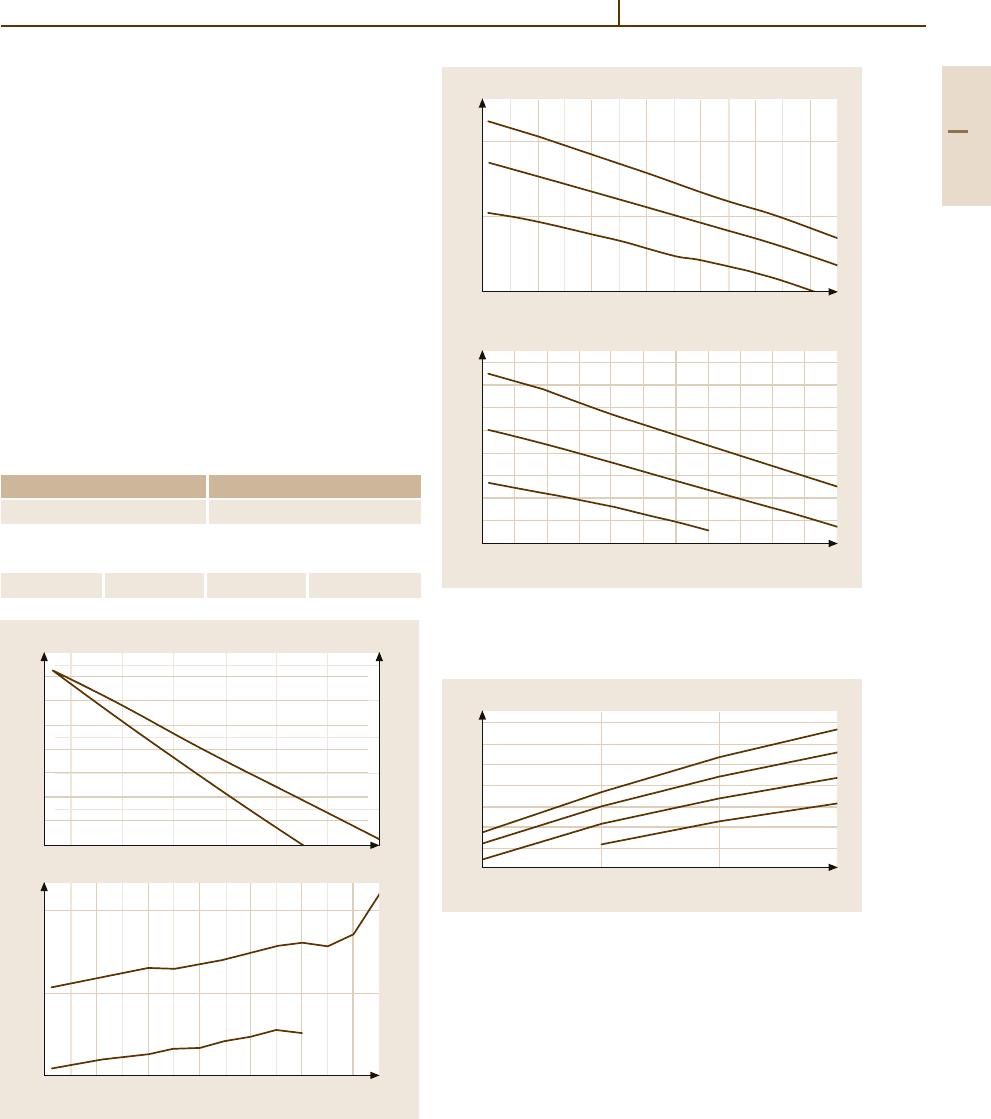
Metals 1.10 Noble Metals and Noble Metal Alloys 395
Mechanical Properties. Iridium is extremely hard and
can only be deformed at temperatures above 600
◦
C,
with repeated annealing steps at temperatures higher
than 1200
◦
C. The Young’s modulus is different for
different crystal directions (Table 3.1-250) [1.216], the
modulus of rigidity is 214 GPa, and the Poisson’s ratio
amounts to 0.26.
Characteristic data of mechanical properties of
Ir and Pt/Ir alloys are given in Tables 3.1-251–
3.1-253 [1.216] and Figs. 3.1-320–3.1-322 [1.289].
Two-phase Ir-based refractory superalloys with fcc and
L1
2
structure of the components (Ir
−
12Zr and Ir
−
17Nb,
Ir
−
15Nb
−
5Ni) have resist temperatures up to 1200
◦
C
and exhibit marked creep resistance (Figs. 3.1-323–
3.1-325) [1.292, 293].
Table 3.1-250 Modulus of elasticity in crystal direc-
tion [1.217, p. 212]
E 110 E 111
47.4GPa 662 GPa
Table 3.1-251 Elastic constants of Ir [1.217, p. 212]
T = 300 K c
11
= 580 c
12
= 242 c
44
= 256
220
210
200
190
180
170
0.30
0.25
0.20
Temperature (°C)
520
500
480
460
440
420
400
380
0 200 400 600 800 1000 1200
a) Young’s modulus E (GPa)
b) Poisson’s ratio v
Modulus of rigidity G (GPa)
E Ir
G Ir
v
D
Ir
v
E/G
Ir
Fig. 3.1-320 (a) Young’s modulus of Ir at different tem-
peratures.
(b) Poisson’s ratio for as cast Ir at different
temperatures [1.289]
250
200
150
0
Temperature (°C)
100
95
90
85
80
75
70
65
60
0
Temperature (°C)
200 400 600 800 1000 1200
100 200 300 400 500 600 700 800 900 1000 1100
b) Modulus of rigidity G (GPa)
a) Young’s modulus E (GPa)
E 30% Ir
E 20% Ir
E 10% Ir
G 30% Ir
G 20% Ir
G 10% Ir
Fig. 3.1-321 (a) Young’s modulus of Pt
−
Ir alloys at differ-
ent temperatures.
(b) Modulus of rigidity of as cast Pt
−
Ir
alloys at different temperatures [1.289]
270
250
230
210
190
170
150
130
0
Iridium concentration (wt %)
10 20 30
25 °C
400 °C
800 °C
1200 °C
Young’s modulus E (GPa)
Fig. 3.1-322 Young’s modulus of as cast Pt
−
Ir alloys at
different temperatures [1.289]
Part 3 1.10
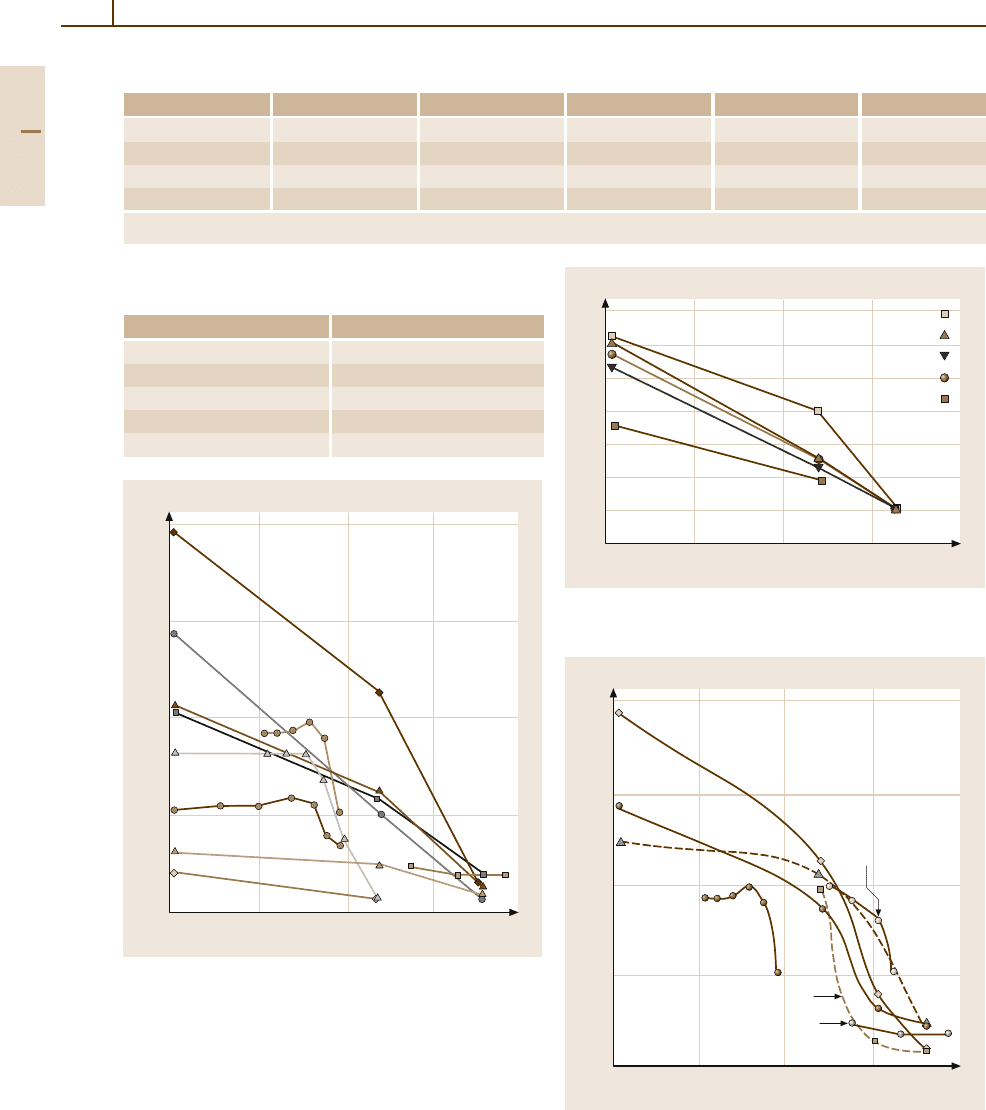
396 Part 3 Classes of Materials
Table 3.1-252 Mechanical properties of Ir at different temperatures [1.217, p. 213]
T (
◦
C) E (GPa) R
m
(MPa) A (%) R
p0.2
(MPa) HV
20 538 623 6.8 234 200
500 488 530 9 12.7 234 138
800 456 450 18 51 142 112
1000 434 331 − 80.6 43.4 97
A = elongation of rupture, E = modul of elasticity, R
p
= limit of proportionality, HV = Vickers hardness, R
m
= tensile strength
Table 3.1-253 Change of hardness of Ir by degree cold
forming V (%) [1.217, p. 312]
V (%) HV
0 240
10 425
20 485
30 475
59 590
2000
1500
1000
500
500 2000
Temperature (°C)
1000 1500
0.2% flow stress (MPa)
Ir-Zr
Ir-Nb
CMSX-10
Ir-Ta
Ir-Hf
Mar-M247
Ni-Al-Cr
Ir-Ti
Ir-V
W alloy
Fig. 3.1-323 High-temperature compression strength of se-
lected Ir-based alloys [1.292, p. 159]
140
120
100
80
60
40
20
500 2000
Temperature (°C)
1000 1500
Specific strength (MPa g
-1
cm
3
)
Ir
75
Nb
15
Ni
10
Rh
75
Nb
15
Ni
10
(Ir
0.75
Rh
0.25
)
75
Nb
15
Ni
10
(Ir
0.5
Rh
0.5
)
75
Nb
15
Ni
10
(Ir
0.25
Rh
0.75
)
75
Nb
15
Ni
10
Fig. 3.1-324 Specific strength of Ir
−
Rh
−
Nb alloys [1.293,
p. 78]
2000
1500
1000
500
500 2000
Temperature (°C)
1000 1500
0.2% flow stress (MPa)
Ir-13.5Nb-8Ni-2Al
W alloy
Nb-Si-Mo-W
Ir-15Nb-5Ni
Ir-17Nb
Ir-12Zr
CMSX-10
Fig. 3.1-325 Comparison of compressive strength of Ir
alloys versus W and Nb/Mo alloys at various tempera-
tures [1.293, p. 77]
Part 3 1.10

Metals 1.10 Noble Metals and Noble Metal Alloys 397
Table 3.1-254 Specific electrical resisitivity [ρ
i
(T ) = ρ
0
+ρ
i
(T )] of Ir at temperatures T (ρ
0
= 0.10 µΩ cm) [1.217,
p. 157]
T (K) 15 40 140 273 700 1100 1500
ρ
i
(T ) 0.0013 0.10 1.96 4.65 13.90 23.20 34.02
Electrical Properties. The residual resistance ratio
(RRR) amounts to 85 (Table 3.1-203). The specific
electrical resistivity at different temperatures and the
dependence of the atomic resistivity are given in Tables
3.1-254, and 3.1-255 [1.216]. The RRR is listed in
Table 3.1-203.
Iridium becomes superconducting below 0.11 K.
Some ternary alloys show critical transition tem-
peratures between3 K andabove8 K (Table 3.1-256)[1.218].
Thermoelectrical Properties. Data for the absolute ther-
moelectric power and the thermoelectric voltage of
Ir, and the thermoelectric voltage of Ir/Rh alloys are
shown in Tables 3.1-206–3.1-208, 3.1-257 [1.216] and
Fig. 3.1-326 [1.217].
Magnetic Properties. Iridium is paramagnetic. Figures
3.1-271, 3.1-327, 3.1-328 [1.216] showthe mass suscep-
tibility of Ir and Pt/Ir alloys at different temperatures.
Iridium exhibits magnetostriction according the equa-
tion ∆l/l = S
l
H
2
, with S
l
=+3.8 (Table 3.1-211).
Table 3.1-255 Increase of atomic resistivity [1.217, p. 158]
Base element ρ/C (µ cm/at.%)
Ir Pt 1.33, Re 2.7, Cr 2, Mo 3.65, W 3, Fe 0.6
Table 3.1-256 Superconducting Ir alloys [1.218, p. 636]
Ir
Compound
T
c
(K)
IrTe3 1.18
Sc5Ir4Si10 8.46–8.38
Y5Ir4Si10 3.0–2.3
Lu5Ir4Si10 3.76–3.72
Table 3.1-257 Thermoelectric voltage of Ir at different temperatures [1.216, p. 95]
T (
◦
C) −200 −100 −50 +100 +200 +400 +800
E
Ir,Pt
(mV) −0.20 −0.35 −0.20 0.66 1.525 3.636 9.246
45
40
35
30
25
20
15
10
5
0
0 2500
Temperature (°C)
500 1000 1500 2000
Thermoelectric voltage (mV)
WRe(97/3)WRe(75/25)
MoRe(95/5)
MoRe(59/41)
Mo-MoRe(59/41)
IrRh(60/40)Ir
Fig. 3.1-326 Thermoelectric voltage of Ir
−
Rh alloys com-
paredtoMo
−
Re and W
−
Re alloys [1.217, p. 474]
3
2.5
2
1.5
1
0 1800
T (K)
300 600 900 1200 1500
Ir
χ
g
(10
–9
m
3
/ kg)
Fig. 3.1-327 Mass susceptibility of Ir at different tempera-
tures [1.217, p. 164]
Part 3 1.10
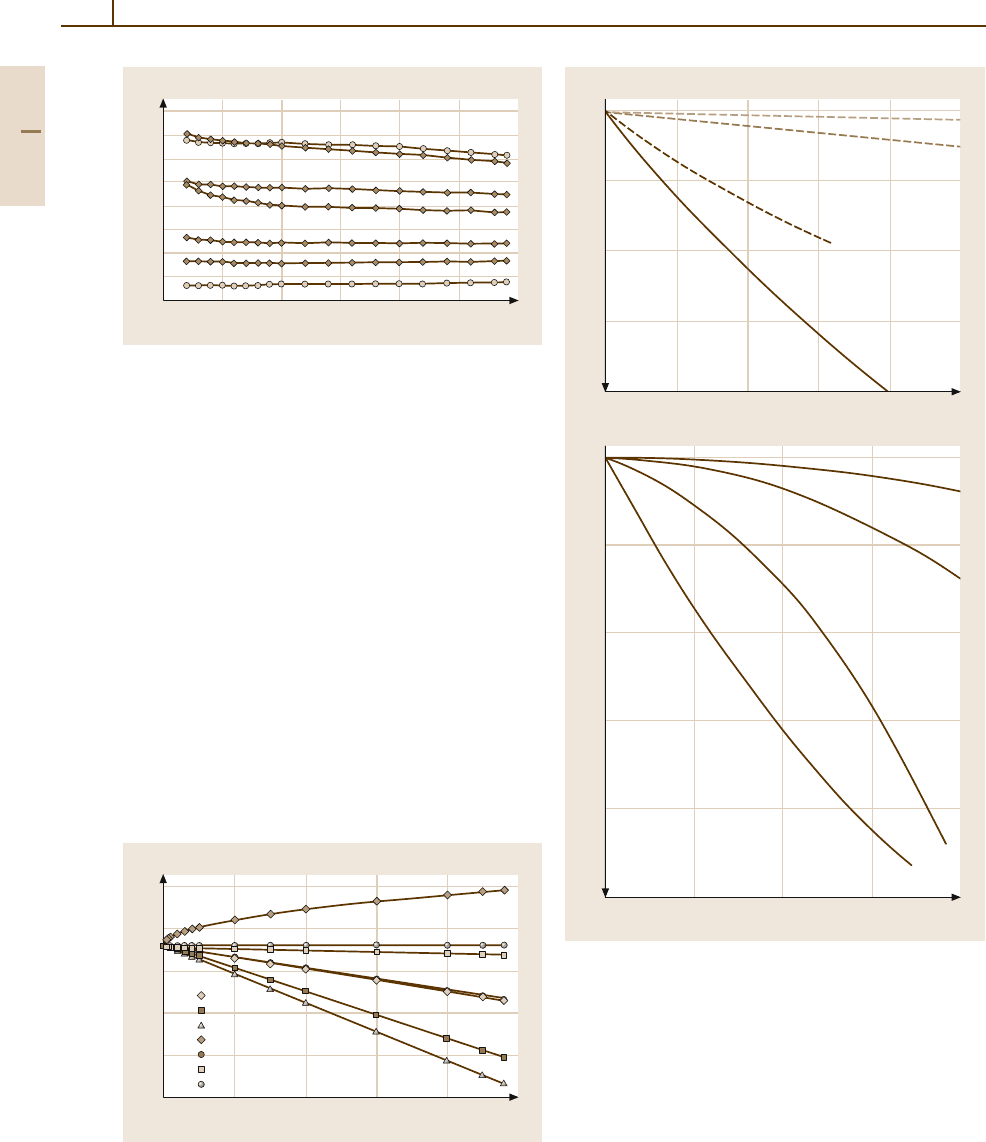
398 Part 3 Classes of Materials
16
14
12
10
8
6
4
2
0
0 300
T (K)
50 100 150 200 250
Ir
x = 0.6870
x = 0.5002
x = 0.3008
x = 0.1987
x = 0.0512
Pt
Pt
1-x
Ir
x
χ
g
(10
–9
m
3
/kg)
Fig. 3.1-328 Mass susceptibility of Pt
−
Ir alloysat different
temperatures [1.217, p. 68]
Thermal Properties.
Tables 3.1-212–3.1-214 give se-
lected data for the recrystallization temperature (varying
by purity, degree of cold forming, and annealing
time), thermal conductivity, and thermal expansion
coefficient.
Optical Properties. The optical reflectivity of Ir is
markedly lower than that of Rh increasing in the wave-
length range from 0.4to0.8 µm (Figs. 3.1-191 and
3.1-274). Data of the spectral emissivity are given in
Table 3.1-216.
Diffusion. Table 3.1-217 gives only one value for self
diffusion of iridium but further information may be
obtained from Landolt–Börnstein [1.238].
Chemical Properties. Iridium is not attacked by acids
or alkali even under oxidizing conditions (aqua re-
70
20
–30
–80
–130
–180
10 50
Time (h)
20 30 400
Ir sheet
IrCr5
IrNb4Ce
IrTi20
IrAl9
IrAl12
RuAl21
Weight change (mg cm
–2
)
Fig. 3.1-330 Oxidation behavior of various Ir alloys at
1000
◦
C in air [1.294, p. 100]
0
30
60
90
120
030
Time (h)
0
2
4
6
8
10
040
Time (h)
6121824
10 20 30
a) Weight loss (10
–2
mg cm
–2
)
b) Weight loss (mg cm
–2
)
(wt% Ir)
40%
30%
20%
10%
1300°C
1200°C
1100°C
1000°C
Fig. 3.1-329a,b Evaporation losses. (a) Pt loss in oxygen.
(b) Pt
−
Ir clad loss in oxygen at 900
◦
C [1.217, p. 184]
gia). It forms volatile oxides in air above 1000
◦
C
but it can be heated up to 2300
◦
C without danger
of catastrophic oxidation. Pt alloys with 1–30 wt% Ir
are corrosion-resistant against H
2
F
2
. Figures 3.1-329
and 3.1-330 [1.216, 294] show data of the evapora-
tion and oxidation behavior of Ir alloys. A detailed
survey on the chemical properties is given in [1.216,
294].
Part 3 1.10
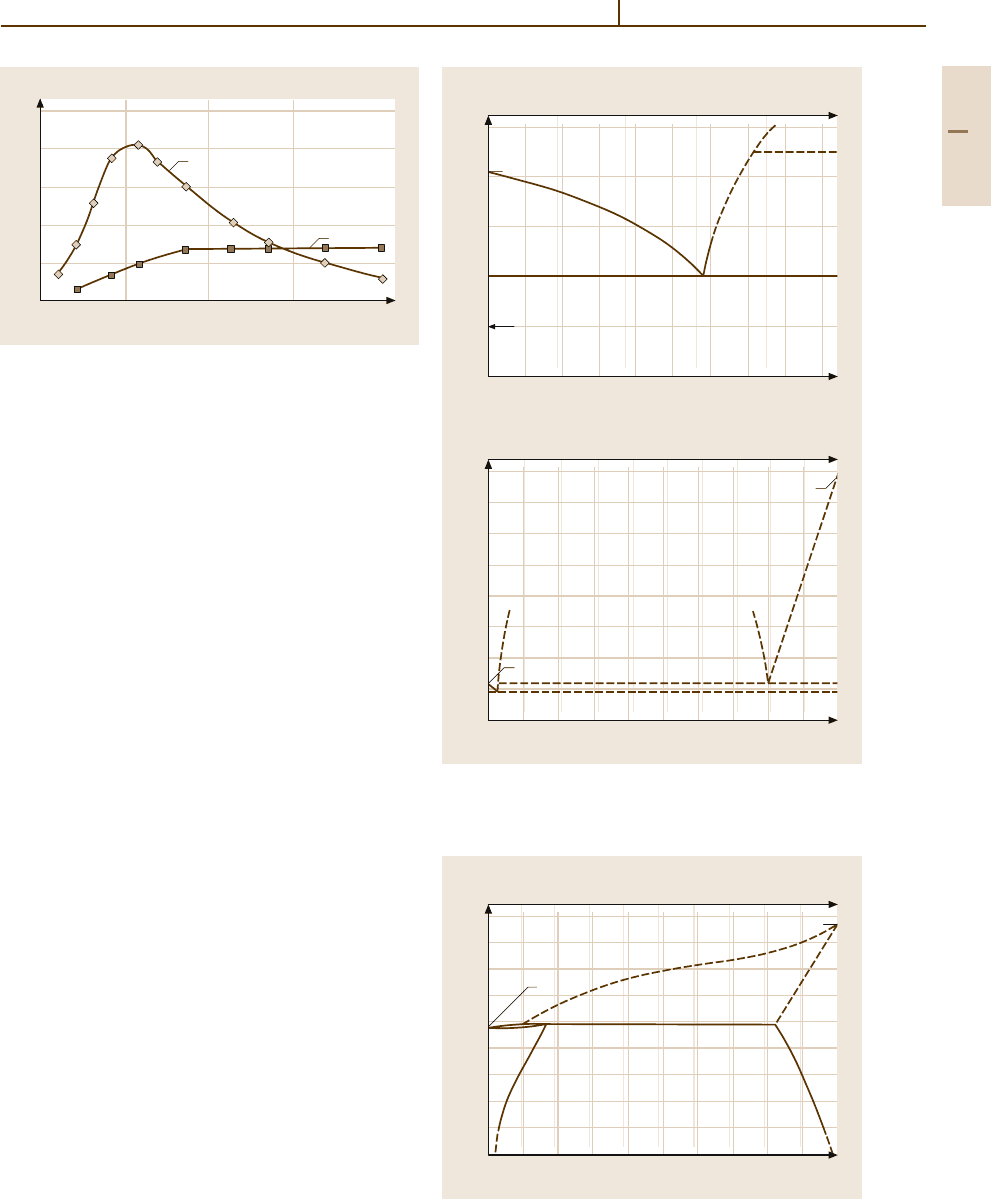
Metals 1.10 Noble Metals and Noble Metal Alloys 399
50
40
30
20
10
520
Water concentration (% w/w)
10 15
Ir/Ru
Rh only
Carbonylation rate (mol dm
–3
h
–1
)
Fig. 3.1-331 Carbonylation rates for Ir
−
Ru and Rh cata-
lysts in methylacetat reactions [1.295, p. 100]
Metal-organic Ir compounds are effective homoge-
neous catalysts for organo-chemical reactions such as
hydrogenation and carbonylation. The technical produc-
tion of acetic acid (“Cativa” process). Figure 3.1-331
shows an example for different carbonylation rates of
Rh- and Ir/Ru-based catalysts [1.295]. Complex or-
ganic Ir catalysts have high stereoselectivity in hydrating
cyclic alcohols [1.216].
Ruthenium and Ruthenium Alloys
Applications. Ruthenium is a component of alloys
and compounds of chemical process catalysts, and Pt-
based catalysts for proton-exchange fuel cells (PEFC).
Because of its corrosion resistance, it is used for
corrosion-preventing anodes in shipping vessels and
under-water structures, pipelines, in geothermal indus-
tries, and as coating of electrodes in chlorine and caustic
soda production. Ruthenium oxide (RuO
2
)andcom-
plexBi/Ba/Pt oxides are materials for electrical resistors.
Ruthenium layers on computer hard discs are used for
high density data storage improvement of data-storage
densities. Ruthenium is an effective hardener of Pd and
Pt. Commercial grades available are sponge, powder,
grains, and pellets in purity ranging from 99–99.95%
(ASTM B 717).
Production. Production of ruthenium starts with chem-
ical reduction of chloro compounds to powder, followed
by compacting to pellets. Coatings are produced by
galvanic processing, evaporation or sputtering.
Phases and Phase Equilibria. Selected phase diagrams
are shown in Figs. 3.1-332 – 3.1-334, thermodynamic
data are listed in Table 3.1-258, and molar heat capaci-
ties can be found in Table 3.1-190. Ruthenium alloyed
980
960
940
920
900
880
0
Ruthenium (wt %)
5
2600
2400
2200
2000
1800
1600
1400
1200
1000
Ru
Ru (at. %)
90
0.5 1 1.5 2 2.5 3 3.5 4 4.5
Ag
Ag 10 20 30 40 50 60 70 80 90
8070605040302010
4321
a) Temperature (°C)
Ruthenium (at. %)
b) T (K)
Ru (wt %)
(Ag) + ?
(Ag)
2.9
L + ?
L
1
+ L
2
L
920°C
962°C
Two liquids
Ag–Ru
1243 K
1193 K
(?)
1235 K
(2553 K)
Fig. 3.1-332a,b Phase diagram of Ag
−
Ru (a) and phase di-
agram of Ag
−
Ru in the high-temperature range
(b) [1.217,
245]
2400
2200
2000
1800
1600
1400
1200
1000
800
600
0
Ruthenium (wt %) Ru
100
10 20 30 40 50 60 70 80 90
Pd
0
100
10 20 30 40 50 60 70 80 90
Temperature (°C) Ruthenium (at. %)
2334°C
L
1583°C
(Pd)
~16.5
~82
(Ru)
1555°C
Fig. 3.1-333 Phase diagram of Pd/Ru [1.217]
Part 3 1.10

400 Part 3 Classes of Materials
Table 3.1-258 Thermodynamic data of Ru [1.217, p. 110]
T (K) c
p
(J/K mol) S (J/K mol) H (J/mol) G (J/mol) p (at)
298.15 23.705 28.535 0 −8.508
400 24.345 35.595 2.449 −11.79 1.50 × 10
−77
800 26.516 53.121 12.611 −29.885 4.83 × 10
−35
1400 30.97 69.01 29.77 −66.844 7.73 ×10
−17
T = Temperature, c
p
= specific heat capacity, S = Entropy, H = Enthalpy, G = free Enthalpy,
p = partial pressure of the pure elements
2800
2600
2400
2200
2000
1800
1600
1400
1200
Pt
Ru(at. %)
10 20 30 40 50 60 70 80 90
1
Ru
10 20 30 40 50 60 70 90
T(K) Ru(wt %)
2607 K
L
(Pt)
2042 K
Pt–Ru
(Ru)
Fig. 3.1-334 Phase diagram of Pt/Ru [1.245]
to Fe lowers the γ –α transition temperature consider-
ably (Fig. 3.1-343). Table 3.1-259 gives the structure
and lattice parameters of intermediate Co and Fe com-
Table 3.1-259 Structure and lattice parameter of intermediate compounds [1.217, p. 117ff.]
Phase Pearson symbol a (nm) b (nm) c (nm) Concentration x A(1 −x)B(x)
Co
−
Ru hP2 0.261 0.4181 0.5
Co
−
Ru cF4 0.3592 0.2
Fe
−
Ru cI2 0.2883 0.06
Fe
−
Ru hP2 0.258 0.414 0.2
Os
−
Ru hP2 0.27193 0.4394 0.5
Table 3.1-260 Mechanical properties of Ru at different temperatures [1.217, p. 229], [1.216, p. 31]
T(
◦
C) R
m
(MPa) A (%) R
p0.2
(MPa) HV
20 500 3 380 250–500
a
750 300 15 230 160–280
b
1000 220 (430) 14 190 100–200
a
a
at different crystal planes,
b
at 600
◦
C
A = Elongation of rupture, R
p
= Limit of proportionality,
HV = Vickers hardness, R
m
= Tensile strength
Table 3.1-261 Hardness (HV 5) of Pd/Ru and Pt/Ru alloys
at 300 K [1.217, p. 230]
Alloying HV 5
metal
alloy conc. (wt%)
0 20 40 60 80
Pd 350 412 425 284 243
Pt 350 330 446 293 253
pounds. The superlattice structures can be found in
Table 3.1-197.
Mechanical Properties. Ruthenium has a Young’s mod-
ulus of 485 GPa, the Poisson’s ratio amounts to 0.29,
and the modulus of rigidity is 172 GPa. Character-
isitic properties of Ru are given in Tables 3.1-260
and 3.1-261. The mechanical properties are marked
anisotropic. The hardness of different single crystal
faces varies between 100 HV and 250HV [1.216]. High
compression-strength alloys are formed by two-phase
Ru
−
Al intermetallic structures. Figure 3.1-335 gives
Part 3 1.10
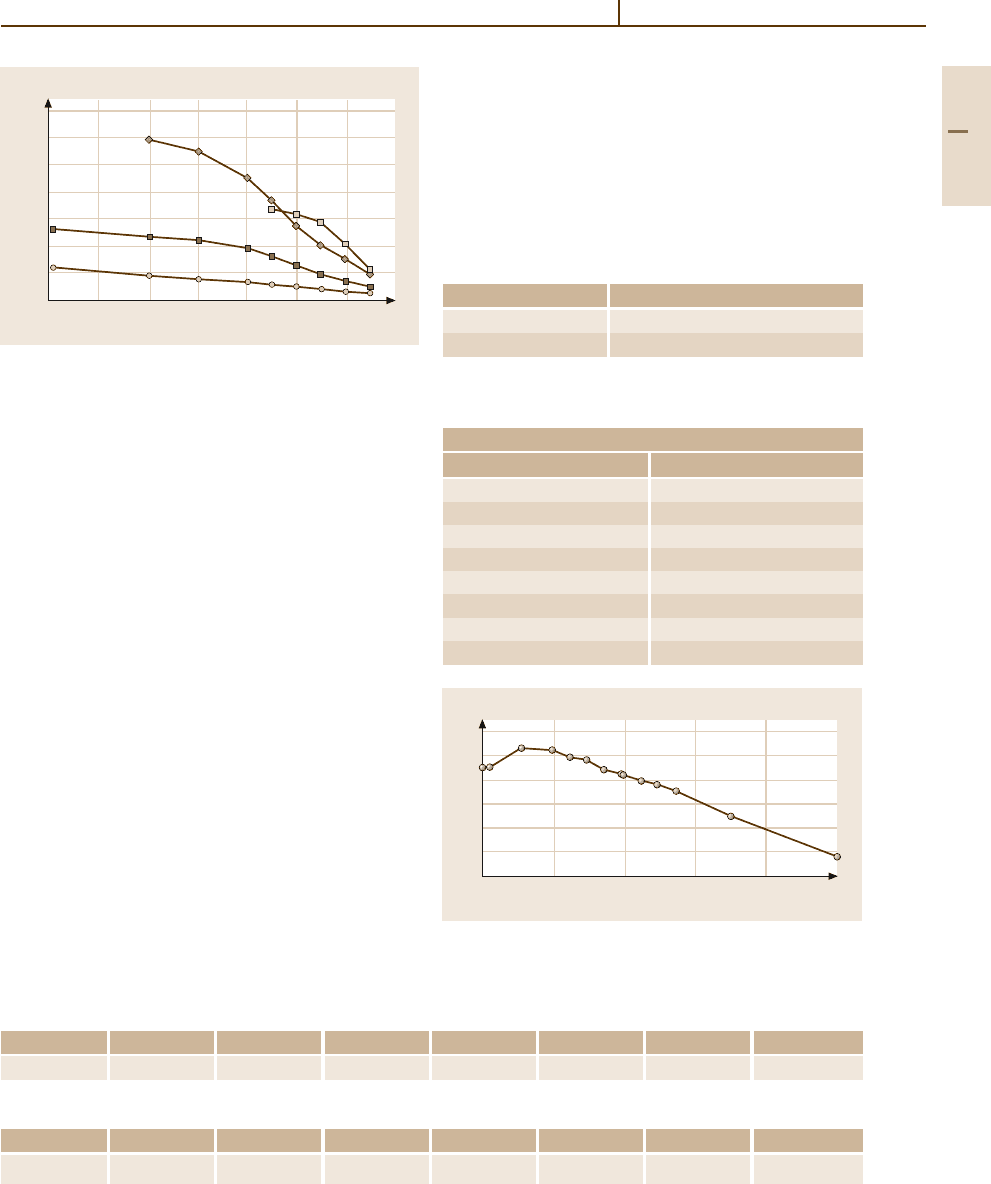
Metals 1.10 Noble Metals and Noble Metal Alloys 401
1400
1200
1000
800
600
400
200
200 1400
Temperature (°C)
400 600 800 1000 1200
0.2% Proof stress (MPa)
RuAl
Ru
Ru–RuAl(RHIP)
Ru–RuAl (melt)
Fig. 3.1-335 High-temperature compression strength of
eutectic Ru-70/Al-30 in relation to its constituent
phases [1.288, p. 164]
an example of molten and hot isostatic-pressed eu-
tectic Ru (Ru-70/Al-30) in relation to the constituent
phases [1.296].
Electrical Properties. The residual resistance ratio
(RRR) amounts to 25 000 (Table 3.1-203). Character-
istic electrical properties of Ru are given in Tables
3.1-203, 3.1-262, and 3.1-263. The specific electri-
cal resistivity of RuO
2
is 3.5×10
−5
Ω cm (1 Ω cm for
PdO for comparison). Together with its low tempera-
ture dependence of the coefficient of resistance, Ru
is suited for the production of resistors in sintered
form or as thick-film layers covering resistors ranging
from ≈ 1.5to10 MΩ. Conductive components are either
RuO
2
,Pb
2
Ru
2
O
6
,orBi
2
Ru
2
O
7
together with additions
of doping oxides [1.218].
Ruthenium shows superconductivity below 0.47 K
[1.218]. Ternary alloys have critical transition tempera-
tures up to 12.7 K (Table 3.1-264).
Thermoelectric Properties. Data of thermoelectric
properties of Ru are given in Tables 3.1-206 and
3.1-265.
Table 3.1-262 Specific electrical resisti vity ρ
i
(T ) (µΩ cm) of Ru at different temperatures (ρ
0
= 0.016 µΩ cm) ρ(T ) =
ρ
0
+ρ
i
(T ) [1.217, p. 156]
T (K) 25 50 100 200 273 300 500
ρ
i
(T ) 0.005 0.105 1.25 4.38 6.69 7.43 13.2
Table 3.1-265 Thermal electromotive force of Ru at different temperatures [1.217, p. 159]
T (
◦
C) +100 +200 +300 +500 +800 +1000 +1200
E
Ru/Pt
0.684 1.600 2.673 5.119 9.519 13.003 16.864
Magnetic Properties. Figures 3.1-271, 3.1-337, and
3.1-336 present data of the magnetic mass susceptibility
of Ru and of Ru/Cr alloy at different temperatures.
Table 3.1-263 Increase of atomic resisitivity by alloying
(∆ρ/C (µΩ cm/at.%)) [1.217, p. 158]
Base element ρ/C (µ cm/at.%)
Ru Fe 0.21, Re 2, Y 1.5
Os Y10
Table 3.1-264 Critical transition temperature of supercon-
ducting Ru alloys [1.218, p. 636]
Ru
Composit T
c
(K)
TiRuP 1.33
ZrRuP 12.34–10.56
HrRuP 12.70–11.08
TiRuAs >0.35
ZrRuAs 11.90–1.03
HfRuAs 4.93–4.37
Y3Ru4Ge13 1.7–1.4
Lu3Ru4Ge13 2.3–2.2
60
50
40
30
20
10
0
0 100
Ru (at.%) Ru
20 40 60 80
Cr
χ
g
(10
–9
m
3
kg
–1
)
Ru–Cr
Fig. 3.1-336 Temperature dependence of the mass suscep-
tibility of Ru/Cr alloy [1.217, p. 166]
Part 3 1.10
